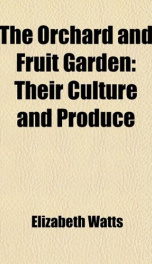the orchard and fruit garden their culture and produce

Purchase of this book includes free trial access to www.million-books.com where you can read more than a million books for free. This is an OCR edition with typos. Excerpt from book: recommend paving-stones for the purpose. Earn down the surface hard, and spread over it a covering of riddled cinders, or gravel, and this paving will pretty effectually keep the roots of the trees from straying into the bad soil below. To make up for bad soil removed, add to the best of the earth dug out whatever the ground most requires, and let it be of the kind fitted to the trees. A naturally dry, sandy soil will be improved by a mixture of clayey loam, and a clay soil will require sandy loam, or road-sweepings; and the parings of commons and the sides of roads and lanes will improve it. In planting, take especial care to keep the collar of the tree well above the surface of the ground. The manure given to enrich the spot should be of the most lasting kind. Nothing is better for the purpose than turf; and as its decaying vegetation is its manuring principle, it may be taken from poor land: dry refuse vegetable matter, such as bean and pea haulm, old thatch or straw, will do, and if animal manure be used, let it be fresh from the stable or cow-house; but introduce these fertilizers at some distance from the root, using a single barrowful of mellow, rather rich soil, to add to the earth in which to plant the tree. CHAPTER III. METHODS OF PBOPAGATION AND IMPBOYEMENT OF KINDS. The mode of propagating fruit trees more practised than any other is grafting or budding good kinds on young stocks. The stocks, or young ungrafted wild trees, are trees which have sprung from seed, suckers springing from the roots of old trees, layers or cuttings. The last two are more difficult to obtain, but if taken from a tree above the graft, their fruit will be of the cultivated kind. It is only when the layer or cutting is laid or taken below the graft, that it will be a stock ...
Info about the book
Author:
Series:
Unknown
ISBN:
1177286629
Rating:
4.5/5 (3)Your rating:
0/5
Languge:
English
Users who have this book
Users who want this book
What readers are saying
What do you think? Write your own comment on this book!
write a commentif you like the orchard and fruit garden their culture and produce try:
Do you want to exchange books? It’s EASY!
Get registered and find other users who want to give their favourite books to good hands!


